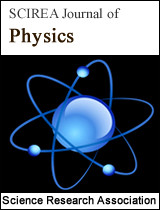An expanded Tauc absorption equation and its application to detect all energy gaps and transition types in the band diagram of bulk Silicon
DOI: 10.54647/physics14469 118 Downloads 13736 Views
Author(s)
Abstract
This work presents an expansion of the Tauc absorption model equation by incorporating into it five proportional factors. The new equation is then solved for the original exponent factor, normally having a value chosen among 0.5, 3/2, 2 and 3, which is related to the optical transition type involved in typical photon absorption processes. Plots of the derived expression along a selected photon energy absorbance range allow, by using a properly adjusted set of the four introduced factors, to detect the energy band gap in the local absorbance range and to confirm the guessed optical absorption type of the material under study. The obtained results are validated by comparing the experimental absorbance data trace against the plot of the expanded absorption equation model and against the energy band diagram, if available, of the material under study. Repeating this process for other segments of the absorbance data provides additional band gaps and absorption types whose nature can be correlated with existing models of energy bands diagrams of the investigated material. The proposed method is applied to bulk Silicon.
Keywords
Photon absorption, Tauc equation, electron transition types, energy band diagram, band gap, Urbach absorption tail.
Cite this paper
Emmanuel Saucedo-Flores, Rogelio Guerrero Gonzalez,
An expanded Tauc absorption equation and its application to detect all energy gaps and transition types in the band diagram of bulk Silicon
, SCIREA Journal of Physics.
Volume 7, Issue 4, August 2022 | PP. 104-113.
10.54647/physics14469
References
| [ 1 ] | J. Tauc, R. Grigorovici, A. Vancu,Optical Properties and Electronic Structure of Amorphous Germanium, Phys. Status Solidi Basic Res. 15 (1966) 627–637. TaucRef1 |
| [ 2 ] | J. Tauc, Optical properties and electronic structure of amorphous Ge and Si, Mat. Res. Bull. 3 (1968) 37–46. TaucRef2 |
| [ 3 ] | J.H. Chu, Z.Y. Mi, D.Y. Tang, Band-to-band optical absorption in narrow-gap Hg1-xCd xTe semiconductors, J. Appl. Phys. 71 (1992) 3955–3961. https://doi.org/10.1063/1.350867. |
| [ 4 ] | B.D. Viezbicke, S. Patel, B.E. Davis, D.P. Birnie, Evaluation of the Tauc method for optical absorption edge determination: ZnO thin films as a model system, Phys. Status Solidi Basic Res. 252 (2015) 1700–1710. https://doi.org/10.1002/pssb.201552007. |
| [ 5 ] | N. Sangiorgi, L. Aversa, R. Tatti, R. Verucchi, A. Sanson, Spectrophotometric method for optical band gap and electronic transitions determination of semiconductor materials, Opt. Mater. (Amst). 64 (2017) 18–25. DOI#5 . |
| [ 6 ] | R. Guerrero-Gonzalez, F.A. Orona, E. Saucedo-Flores, R. Ruelas, J.E. Pelayo-Ceja, R. Lopez-Delgado, A. Cordova-Rubio, M.E. Álvarez-Ramos, A. Ayon, Synthesis of Si and CdTe quantum dots and their combined use as down-shifting photoluminescent centers in Si solar cells, Mater. Renew. Sustain. Energy. 8 (2019) 1–8. https://doi.org/10.1007/s40243-019-0153-0 |
| [ 7 ] | J.C. Melendres-Sánchez, R. López-Delgado, G. Saavedra-Rodríguez, R.C. Carrillo-Torres, R. Sánchez-Zeferino, A. Ayón, M.E. Álvarez-Ramos, Zinc sulfide quantum dots coated with PVP: applications on commercial solar cells, J. Mater. Sci. Mater. Electron. 32 (2021) 1457–1465. https://doi.org/10.1007/s10854-020-04916-0 . |
| [ 8 ] | Optical Properties of Silicon | PVEducation, (n.d.). SiliconAbsorbance (last accessed April 7, 2022). |
| [ 9 ] | Figure used by Helmut Föll and Jürgen Carstensen gentility, "Free quantum mechanical particles and band structure". BandDiagram (last accessed April 7, 2022). |

